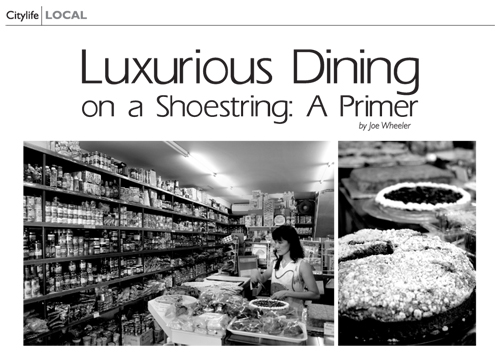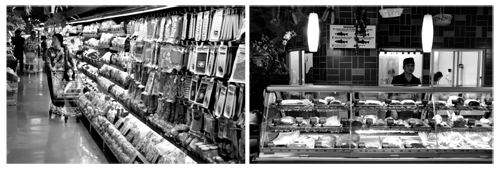
“You don’t need a silver fork to eat good food.”
Paul Prudhomme
“Happy cooking.”
Jacques Pepin
There’s a lot of good, luxurious, satisfying food that you can enjoy in Thailand, without breaking the (your) bank. Recently, I was strolling through my local market and saw a bucket of frogs. It reminded me of a restaurant in my home town that specialised in alligator tails and frog legs _ expensive, but I used to treat myself once in a while. I wondered if I could re-create the frog leg experience in Thailand. I went home and searched for information on the ‘net. First I found a recipe that sounded tasty. Then I found, on YouTube, a video shot by some “good ol’ boys” out gigging frogs in the Florida Everglades. Drinking their Bud and teaching me how to skin the catch. It all seemed simple. I went back, bought the frogs, and prepared them according to the video and the recipe. They tasted just as I remembered and not at all expensive. Since I used only the legs, I gave the bodies to a Thai neighbour and they made soup (tom yum gop.)
Every meal should be a small festival. It is a time for a celebration of life. Mealtime is a time for sharing with others _ a daily communion without the theophagy. You can make a fine meal without having a lot of equipment in the kitchen. In my house, we have a two burner gas stove, a small, round convection oven and a slow cooker/crock pot (total investment around 3,500 baht.) Oh yeah, a frying pan, a wok and a couple of beat-up aluminum pots. Even when cooking for 10+ people I find that with a little thought and careful planning it is possible to create a luxurious meal and still enjoy a fun, low stress evening. Using the convection oven, you can make anything that can be made in a standard oven, but in smaller quantities. You can bake a chicken or make a pan of quick bread such as biscuits, scones, or corn bread. You can BBQ ribs, grill a steak, or make a pizza. With the slow cooker, you can cook stocks (make and freeze until needed), soups, stews, appetisers, paella or arroz con pollo, chicken tikka masala, chili, spaghetti sauce.
Besides being able to prepare delicious, low cost meals, there are other benefits to a minimalist approach. If you use the crock pot and the convection oven, you save energy and do not have to fire up a big oven to roast a chicken. With the slow cooker, you can put in the ingredients of whatever you are preparing and let it cook. No tending, no stirring _ and as Alton Brown says, “Walk away, just walk away.”
“Bon appétite”
Julia Child
A meal lacking flavour is like a Ferrari with no engine. The car is sensual and exciting from a distance, but it doesn’t move you. The same can be said for a meal with little taste.
Good, intense flavour will not happen unless you give some thought and prep work before you begin cooking. Emeril LaGasse talks about “kicking it (flavour) up a notch” as he adds some unexpected ingredient to his dish. Paul Prudhomme has a theory about “layers of flavour.” In his pursuit of flavour complexity, he goes so far as to recommend adding herbs and aromatic vegetables at least twice when preparing a dish. He says that long cooked aromatics have a “darker” taste than those cooked for a shorter time. The combination of dark and light tastes increases the flavour and complexity of a preparation.
When you become inspired to try out a new dish, first check the internet for recipes. Read several different recipes and choose two or three that sound good to you, then meld them together into a single recipe. Don’t be afraid to experiment. As Roger Verge said, “A recipe is not meant to be followed exactly – it is a canvas on which you can embroider.” Try to think (a bit) outside the box. Here are a couple of examples. Jacques Pepin likes to add a bit of orange zest to his braised veal shanks just a bit before they are done to heighten the complexity and interest of the dish. If you are grilling a pork steak, sprinkle the steak with allspice as well as salt and pepper before grilling. The allspice provides a completely new flavour profile to the pedestrian grilled pork.
“Where’s the beef?”
Clara Peller (former spokesperson for Wendy’s Restaurant)
Well, actually Clara that is a good question, especially in Thailand. Fortunately in Chiang Mai ingredients for most recipes are available, although you may have to search. And remember, there’s always the internet if you can’t find what you need or can’t think up a “work around.” Readily available is good pork, chicken and duck at a fair (but not as fair as it used to be) price. Shrimp and fresh water fish (especially tilapia and tab tim) are also bountiful and cheap. Tab tim filets work very well for fish and chips. Good beef and lamb are more difficult to find, but can be found. If you can’t find veal you can substitute either scaloppini of pork or chicken. Since most meat without fat doesn’t have much taste, little damage is done to the final dish (unless you are a purist.)
Here is a list of several markets where you can usually locate hard to find items.
Tesco-Lotus has a number of run of the mill western food items such as pasta, peanut butter, oatmeal, etc. They are generally convenient and have fair pricing.
Rimping Supermarkets are a bit more expensive than Tesco, but have a wide selection of western products. They have fresh herbs, a good selection of meats and deli products, and a number of cheeses. At Rimping you can find everything you need to make dishes such as chicken tikka masala or huevos rancheros.
Northern Farms is similar to a western butcher shop. They offer imported beef and lamb in several different price ranges. It is a good place to buy hamburger (minced beef) and steaks. The store also has some canned goods, pasta and wines.

The Kasem Stores are a Chiang Mai institution. The entire store is devoted to western products. These markets sell primarily dry goods (e.g., breakfast cereals, pickles, dried beans, and various sauces) and they sell some good baked items (especially carrot cake and apple turnover.)
Horeca is a restaurant supply house and not a retail operation. However, they supply a number of restaurants with meats, dry goods, coffee, etc. If you have a favourite restaurant and know the owner, you can check his Horeca catalog and see if there is anything of interest to you. Then just ask him to order the items you want the next time he places an order.
There are two warehouse type stores in Chiang Mai – Makro and Yok.
Makro is a membership store, but the membership is free. If you have any old business cards, take one in on your first visit and see if they will let you sign up. Alternatively, just walk to the counter to the right of the entrance and fill out a ‘onetime visit’ card. Write the name, in English, of a Thai you know (your partner, friend, etc.) They will look it up on the computer and not be able to find it. Then they will probably ask you if you are a member. Say ‘yes.’ They will then validate the one time visit card and you are in. I will probably be deported for giving out this tip.
While Makro offers many items in bulk, they have several hard to find items of interest. In the frozen section they sell lamb shoulders which my Australian friend told me are not much more expensive than in Australia. There is also a nice frozen fish filet which has a mild taste and white, flaky meat. In the coolers, you can find a 3 kilo package of mild cheddar as well as a large round of Gouda.
Yok is a new store for me. They sell in case lots but also break up cases and pass the savings along to the customer. They have any kind of baking ingredients and baking accessories you could want. In the dairy section, they re-package large cartons of butter (unsalted and salted), cream cheese, lemon curd, etc. Yok is clean and the staff is friendly. They try to be helpful although English (for instance) is not one of their strengths. Just smile, point and use sign language if you cannot find what you want. The market is worth at least one visit.
“Sometimes you have to bite the bullet”
Howard
I’ve lived in Chiang Mai for 10 years and there are still two food groups that I continuously jones for _ wine and cheese. There is a 54% duty (tariff) paid on imported wine. There is a further excise tax paid on the import duty. Hence, a reasonably priced $10 (300 baht) bottle of wine in California will cost you $16+ (480+ baht) BEFORE all of the internal Thai taxes are added. Therefore, even for plonk, you pay a price higher than you would normally expect. When the price is coupled with questionable storage conditions, you never know if the wine you buy will be good or turned. There are two strategies to use when buying wine in Chiang Mai. The first is to buy from high end wine stores for special occasions. Then, for everyday drinking, think about “bag-in-a-box” wine. You can get a five litre box for around 1,000 baht. It’s a lot of wine but the bag collapses as wine is dispensed and protects the wine from the air.
A good selection of cheeses are available in Thailand which are as expensive, or more so, than in your home country. Once again, if you want cheese for a special occasion, you will have to bite the bullet and spend some money. Makro sells large packages of cheddar and Gouda, at a considerable savings over smaller packs. If you want to keep cheese on hand for everyday use, go in with two or three friends and divide the bounty.
There are few barriers to cooking good tasting, even luxurious meals in Chiang Mai. You can equip a functional kitchen for little money, recipes are readily available, and ingredients are available. Get started! As Jonah Lehrer, in a critique of rationalist philosophy using a cooking analogy wrote, ‘To cook is to insist that every hunger is a potential occasion-and Virginia Woolf was right: “Of such moments the thing is made that endures.” We have taken a need and made a meal.’